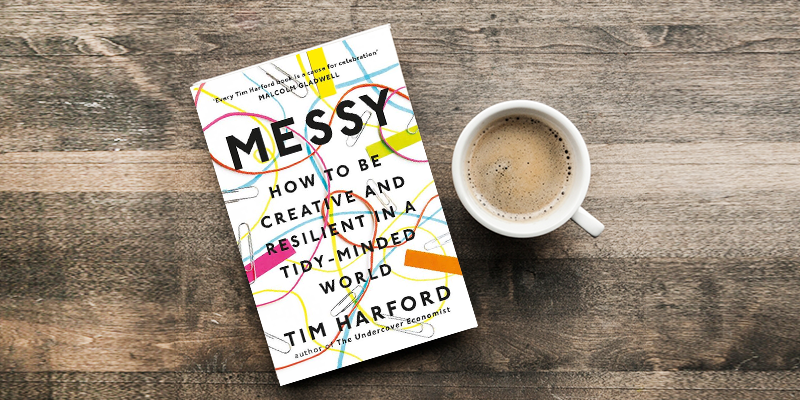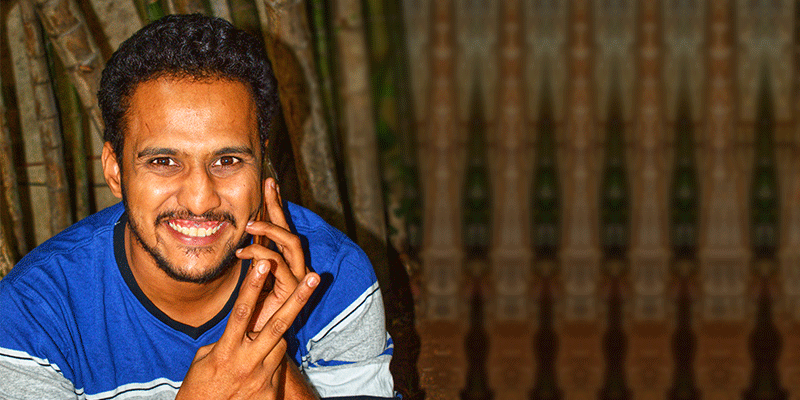Messy but creative: why messiness is important in innovation, arts, education and more
A certain degree of messiness spurs innovation through alertness, resilience and creativity. These principles have worked for Jeff Bezos, Miles Davis and MIT. In fact, messiness is what makes us so human, as this provocative book argues.

It may be human to want to be tidy, planned, systematic and structured – but there is also a risk that too much scripting makes things sterile, fragile and rigid. There is much hype today about creativity and resilience – but that also calls for tolerating and even encouraging messiness in some contexts, according to the book Messy: How to be Creative and Resilient in a Tidy-Minded World.
Tim Harford is the author of Fifty Things that Made the Modern Economy (see my book review and author interview). His other books are The Undercover Economist, Adapt, and The Logic of Life. Tim is a columnist for the Financial Times, presenter at BBC, and visiting fellow of Nuffield College at Oxford University.
Messiness can even bring out the best in us, Tim begins in his 330-page book. He cites a wide range of examples and research to show how the principles of messiness apply to the worlds of education, business, politics, science and art.
In a world of uncertainty, some amount of messiness makes you more alert, perceptive, responsive and improvisational. Confusion and clarity both have a place in the road to success; a balance of tidiness and messiness can work well in personal, social, organisational and national settings.
Here are my key takeaways from the nine chapters in this highly entertaining and insightful book. See also my reviews of the related books The Art of Creative Thinking, Ideas are Your Only Currency, 12 Steps to Creativity, and Creativity Now.
1. Creativity
Jazz pianist Keith Jarrett once had to play on a faulty piano at a show – the album ‘The Koln Concert’ turned out to be one of the best solo piano albums of all time because the faulty instrument pushed him beyond his usual artistic limits in terms of creating new techniques and patterns.
Other musicians such as Brian Eno promote chaos and randomness deliberately and not by accident. He had a deck of cards called ‘Oblique Strategies,’ each with music instructions such as ‘change instrument roles’ or ‘emphasise the flaws.’ Musicians were told to play different instruments and on unusual scales. One of David Bowie’s albums is aptly called ‘Planned Accidents.’
Unplanned and even planned distractions can also be effectively harnessed in creativity - they help create new kinds of cross-pollination between “foreground” and “background” activities. For example, akin to crop rotation in nature, project switching is a technique used by scientists (Alexander Fleming, Louis Pasteur) as well as artists (David Bowie, Michael Crichton). Others even advocate breaking the routine by switching work roles or jobs regularly.
The company 3M has a “flexible attention policy” to allow companies to work on other activities during office times. Its teams are known for creating new products through creative combinations -- such as cellophane wrapping-paper with glue, leading to Scotch tape.
Fresh contexts, useful diversion, daydreaming and even procrastination can spur new connections in the mind and remove creative blocks. It also helps to collect project ideas and document them so that you don’t miss out on sources of creative connections.
2. Collaboration
Strong bonds as well as distant bridges help in creative work. Effective performance requires team collaboration, but sometimes teams need to unplug and work in isolation. In networks of connections, it is often the weak ties or distant relationships that yield good insights and contacts.
Networks of diverse teams unleash creative tension and even dissonance in clusters, which have been effectively harnessed in industries as diverse as computer games and movies. “Cognitive diversity is a recipe for creativity and an antidote to groupthink,” says Tim. It helps move away from lame conformity, complacency, consensus and self-censorship, and promotes creative dissent.
“The modern world is full of opportunities to meet new people,” says Tim, but for better networking we need to make an effort to seek out people different from us, and get out of our own bubbles. Conversations with strangers can bring out new kinds of creative sparks.
Other studies show that goal harmony is more important than team harmony; with an overarching, important and compelling goal, people are willing to set aside differences and work together. Bonding, conflict and reconciliation can lead to new levels of performance excellence.
3. Workplaces
Much attention has focused on the connection between workplace design and employees’ creativity and performance. One school of thought calls for tidy, minimalist spaces that draw on the ‘5 S’ framework – sort, straighten, shine, standardise and sustain. This works well in factory floors, but not offices, argues Tim. A blend of seriousness and play could work better instead.
Workplaces should be inspiring and empowering, not just comfortable or pleasant; it helps to have elements of participatory design as well. “Hard” elements (such as location of windows) should be blended with “soft” elements (personalisation with family photographs, souvenirs, scribbled storyboards). Some managers have promoted excessive tidiness and neatness, but at the cost of deep resentment from employees.
MIT’s Building 20 was an ugly building constructed during World War II – but produced nine Nobel Prize winners as well as technologies like radar, commercial atomic clocks, anechoic chambers and Bose speakers. The building housed defence, data processing, press, photography and even linguistics centres. The messy building with disorderly room numbering let its residents poke around and even do wiring on their own, eventually spawning hacker culture and video gamers as well.
“The unlikely mess made possible chance interactions among innovative researchers that paid such spectacular dividends,” Tim observes. Google’s headquarters over the years also have had mish-mash elements of the “anything goes” mentality (the company was even in a garage in 1998).
Steve Jobs insisted on office space designs that promoted serendipitous interactions, such as an atrium that connects cafes, mailboxes, conference rooms, and gaming areas. Networking happened more in Pixar’s employee-designed creative Love Lounge than around elegant conference-room tables with place cards.
What matters more than how the place looks is what it does; people flourish when they control their own space, argues Tim. Offices are workplaces and not tidy cemeteries.
4. Improvisation
Martin Luther King used to meticulously prepare for his speeches, but his most famous speech of all was improvised as he went along. He departed from the script, listened to the crowd, and felt out their responses. The speech originally titled “Normalcy, Never Again” became the legendary “I Have a Dream.”
Jazz trumpeter Miles Davis preferred to record first-takes for his albums, rather than re-recording and splicing. Some of the tracks contain what may come across as mistakes, but became triggers for amazing solos.
“Improvising musicians shut down their inner critics,” says Tim. By stopping excessive filtering of ideas, they allow the mess of new ideas to flow out, which can produce flashes of pure brilliance. Stand-up comedians are also masters of improvisation. Success requires a willingness to cope with messy situations.
“Sometimes the mess produces something worth having – even, or especially if, it wasn’t what you were aiming for,” Tim explains. Scripts are like bulletproof vests but can sometimes become straitjackets.
Zappos gives its employees a certain amount of freedom to improvise in the ways they serve customers, eg. an employee gave flowers to a customer who lost her husband. Mobile operator O2 once faced an outage lasting more than a day; one of its customer service representatives spontaneously took to responding to angry tweets with a sense of humour. This brought out the human side of the company, and received a lot of admiration.
But the use of humour by business during times of crisis is a fine line to tread, has a finite shelf life, and can’t always be repeated.
5. Winning
What do Bezos, Rommel and even Trump have in common? They used mess as a weapon in business, politics and war. Erwin Rommel used confusion in the battlefield to create opportunities, even though it sometimes confused his own troops. Momentum was more important than pausing and regrouping.
The British SAS forces also preferred the messy approach of surprise attacks and improvisation along the way. In politics, Donald Trump changes the conversation whenever he wants via unpredictable tweets.
Jeff Bezos of Amazon believes in shock-and-awe tactics and speed over perfection in the race of e-commerce disruption. In the early days of getting into the toy sales business, he even bought toys from competitors in a mad scramble and dispatched them to his own customers during Christmas season.
Conviction, improvisation and luck have driven Amazon’s forays into Kindle, Mechanical Turk, FirePhone, and MarketPlace. The fast-and-messy momentum helped drive the company into the cloud market four years ahead of Microsoft’s Azure. The company has also outflanked the ponderous moves of bricks-and-mortar retailers like Barnes and Noble, though it has lost money on some other ventures.
6. Incentives
Setting orderly targets and incentives to improve performances sometimes falls flat on its face due to unintended consequences like gaming of the system. Some US states issued report cards on how many successful heart operations surgeons had – this drove some of them to avoid operating on old patients and only choose healthier ones.
Sometimes, targets promote “short-termism” and not long-term performance. Cutting on training costs can increase short-term profits, but cause long-term loss of skills to a company.
Some reports rank US universities on how selective they are in degree programme admissions. In response, some universities launched extensive marketing campaigns to drive up application rates – so that more applicants could be rejected, thus making the university look more selective.
The US has set automobile targets for emission rates to be verified at testing stations – but Volkswagen infamously cheated the system by ensuring better emission standards during tests than on the road. The UK NHS set an eight-minute target for ambulance services – but this caused some companies to cut services in rural areas, or move crews out of hospitals closer to accident-prone areas.
7. Automation
From meteorology to aviation, automation has reduced the risk of human error – but not yet created 100 percent fail-proof systems, as the crash of Air France Flight 447 over the Atlantic has shown. Clear handovers between human and automated modes of operation need to be specified, otherwise removing the mess in human operation can lead to larger and complicated messes of machines.
Automation reduces original human competence in the targeted skills, and can cause new kinds of unprecedented failure. “Digital devices tune out small errors while creating opportunities for large errors,” cautions aviator Earl Wiener. A popular joke goes like this: “To err is human, but to really foul things up takes a computer.”
Malaysian lecturer Rahinah Ibrahim was placed on a US no-fly list when her affiliation to professional association Jemaah Islah Malaysia was confused with terrorist organisation Jemaah Islamiyah.
Errors in automation can cause judgement problems to increase. For example, it is not always easy for a computer to guess if a stationary car is parked illegally or stuck in traffic.
Automated systems also lull us into passivity and blind trust (“automation bias”), cautions Tim, pointing to navigation mistakes that some passengers have experienced with GPS. Care should be taken to ensure that automation supports but not totally supplants human judgement.
“It is possible to resist the siren call of the algorithms,” urges Tim. In many domains, a generation of retiring experts is causing risk when their intuition and skills are lost to automated systems.
8. Resilience
There is also a lot of messiness in nature, but this messiness has elements of balance in it – as show in biodiversity of forests and the role of bacteria in human beings. “In nature, mess often indicates health,” observes Tim.
In some areas of Germany, orderly forests of Norwegian spruce trees were created, and dead trees systematically removed. Unfortunately, this led to loss of biodiversity and soil quality decades later, and forests declined.
Human beings often take excessive antibiotics, but this also kills beneficial bacteria. Some bacteria cause certain types of disease, while also reducing other factors like allergy. “Mess makes natural systems more healthy and resilient,” says Tim.
Diversity may have a certain messiness in it, but it helps formation of creative neighbourhoods and improves the output of mixed industrial clusters. Specialisation and homogeneity may have short-term advantages, but are fragile and lose out in the long race of creativity and innovation.
“In organisations, politics, marketplaces and personal lives, we continue to enjoy the apparent convenience, neatness and short-term profits of imposing order, and fail to notice when it is sowing the seeds of fragility,” cautions Tim.
9. Life
Messiness also has value in our communication and education. Much research has addressed the work habits of “neats and scruffies,” or “filers and pilers,” jokes Tim.
Categorising documents into folders or tags has challenges due to the multiple facets of information; messy approaches may be better depending on individual habits, or search tools across an organisation. Classification is important in libraries, but takes time for individuals to create and can even cause undue attachment to the classification system.
Some people prefer calendaring all activities months in advance, others plan each day as it comes. Some see daily plans as stifling, and prefer looser monthly plans.
Matchmaking and compatibility algorithms have been used in domains as varied as recruitment and dating – with mixed results. Some desired qualities are hard to specify in neatly-defined attribute categories. Chatbots work well in structured domains, but less so in context-rich and messy conversations.
Playgrounds today are designed to minimise mishaps and reduce the risk of lawsuits, but messy play areas improve children’s alertness to risk. Parents today over-protect children, but this may be limiting their scope to become fully human, cautions Tim.
“Life cannot be controlled. Life itself is messy,” Tim says. Openness and adaptability should not be undervalued in the face of tidy predictability. “Real creativity, excitement and humanity lie in the messy parts of life, not the tidy ones,” he signs off.








![[Funding alert] JetSynthesys raises Rs 300 cr from Poonawalla, Kris Gopalkrishnan](https://images.yourstory.com/cs/2/b87effd06a6611e9ad333f8a4777438f/Image84pl-1594114133552.jpg)


